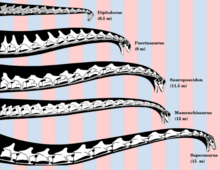Eusauropoda
| Eusauropods | |||
|---|---|---|---|

| |||
| Skull of Jobaria | |||
| Scientific classification | |||
| Domain: | Eukaryota | ||
| Kingdom: | Animalia | ||
| Phylum: | Chordata | ||
| Clade: | Dinosauria | ||
| Clade: | Saurischia | ||
| Clade: | †Sauropodomorpha | ||
| Clade: | †Sauropoda | ||
| Clade: | †Gravisauria | ||
| Clade: | †Eusauropoda Upchurch, 1995 | ||
| Subgroups | |||
| |||
Eusauropoda (meaning "True Lizard Foot") is a derived
Eusauropoda are herbivorous, quadrupedal, and have long necks. They have been found in South America, Europe, North America, Asia, Australia, and Africa.[3] The temporal range of Eusauropoda ranges from the early Jurassic to the Latest Cretaceous periods.[1] The most basal forms of eusauropods are not well known and because the cranial material for the Vulcanodon is not available, and the distribution of some of these shared derived traits that distinguish Eusauropoda is still completely clear.[1][4]
Description
Eusauropods are long-necked, strictly
Teeth and mouth
Yates and Upchurch described eusauropod evolution as moving towards a “bulk-browsing mode of feeding”. They describe the development of lateral plates on the alveolar margins of tooth-bearing bones. These plates can be used to strip foliage, the eusauropod's “U-shaped” jaws create a wide bite, and their loss of “fleshy cheeks” increased the gape.[6] The crowns of eusauropod teeth also have “wrinkled enamel textures”, but it is unclear what this meant for their feeding habits.[1]
Head and neck

The skull length of the basal eusauropod, Patagosaurus is about 60 centimetres (24 in).[7] One of the most basal eusauropods, Shunosaurus, has two characteristic features of the eusauropod elongated neck: the incorporation of the equivalent of the first dorsal vertebra into the cervical region of the spine, and the addition of two cervical vertebra in the middle of the cervical vertebrae.[4]
Other
Feet and limbs
Eusauporoda are also hypothesized to have a semi-digitigrade foot posturem demonstrated by footprint evidence.
Distribution
Eusauropods are found on all major continents, with diplocodoids being widespread in the Northern Hemisphere, and titanosaurs being found in Southern Hemisphere. However, basal eusauropods that do not fall into either group are fairly well represented.[9]
Early eusauropods such as Volkeimeria and Amygdalodon, and more derived eusauropods such as Patagosaurus have been found in South America.[7] Volkeimeria is classified as a basal eusauropod, though in 2004 Paul Upchurch was suspicious of its placement, because of its “opisthoceolous cervical centra, the absence of a femoral anterior trochanter, and laterally projecting cnemial crest of the tibia”, and instead thought it may be a generic sauropod.[9]
African eusauropods may include Spinophorosaurus, from Niger, although that taxon may instead be closer to Vulcanodon and outside Eusauropoda.[3][8] Also, Atlasaurus was found in Morocco, and Jobaria was found in Niger. However, both genera have been found as possible Macronarians, but Atlasaurus was found to be a turiasaurian, and Jobaria a eusauropod, by a phylogenetic analysis of Xing in 2012.[3][9]
In Europe, the clade Turiasauria has been found in France, Spain, and possibly England, with multiple genera from the same locality in Spain.[9][10] Cetiosaurus skeletons have also been found in England, along with the possibly eusauropod genera Cardiodon and Oplosaurus, known only from teeth.[9]
The family Mamenchisauridae is found widespread throughout Asia. A majority of the genera are found in China, although a possible specimen of Mamenchisaurus has been found in Thailand.[3][9] Also in China, the basal eusauropod Nebulasaurus taito was found to be a sister taxon to Spinophorosaurus, and more derived than Mamenchisauridae, but less derived than Patagosaurus, and the genus Shunosaurus is likely one of the most basal eusauropods.[3][9] The genus Barapasaurus has been found in India, and may represent a cetiosaurid, a basal eusauropod, or a genus outside Eusauropoda.[3][8][9]
Paleobiology
The data around sauropods evolution, as Novas points out, is largely based on a few formations mostly in the Northern Hemisphere. However, other beds in places such as Tanzania, specifically the Canadon Asfalto and Canadon Calcereo formations reveal a more diverse and widespread peleobiology of eusauropods in the Late Jurassic period.[7]
Classification
The following cladogram demonstrates hypothesized relationships within the Eusauropoda.[11] The basal eusauropods include the Turiasauria (Turiasaurus, Zby and others.[12]
| Eusauropoda | |
References
- ^ ISBN 978-0-520-24623-2.
- .
- ^ .
- ^ .
- PMID 23638372.
- ^ PMID 19906674.
- ^ ISBN 978-0-253-35289-7.
- ^ S2CID 85317450.
- ^ ISBN 0-520-24209-2.
- .
- PMID 21251189.
- S2CID 59387149.
